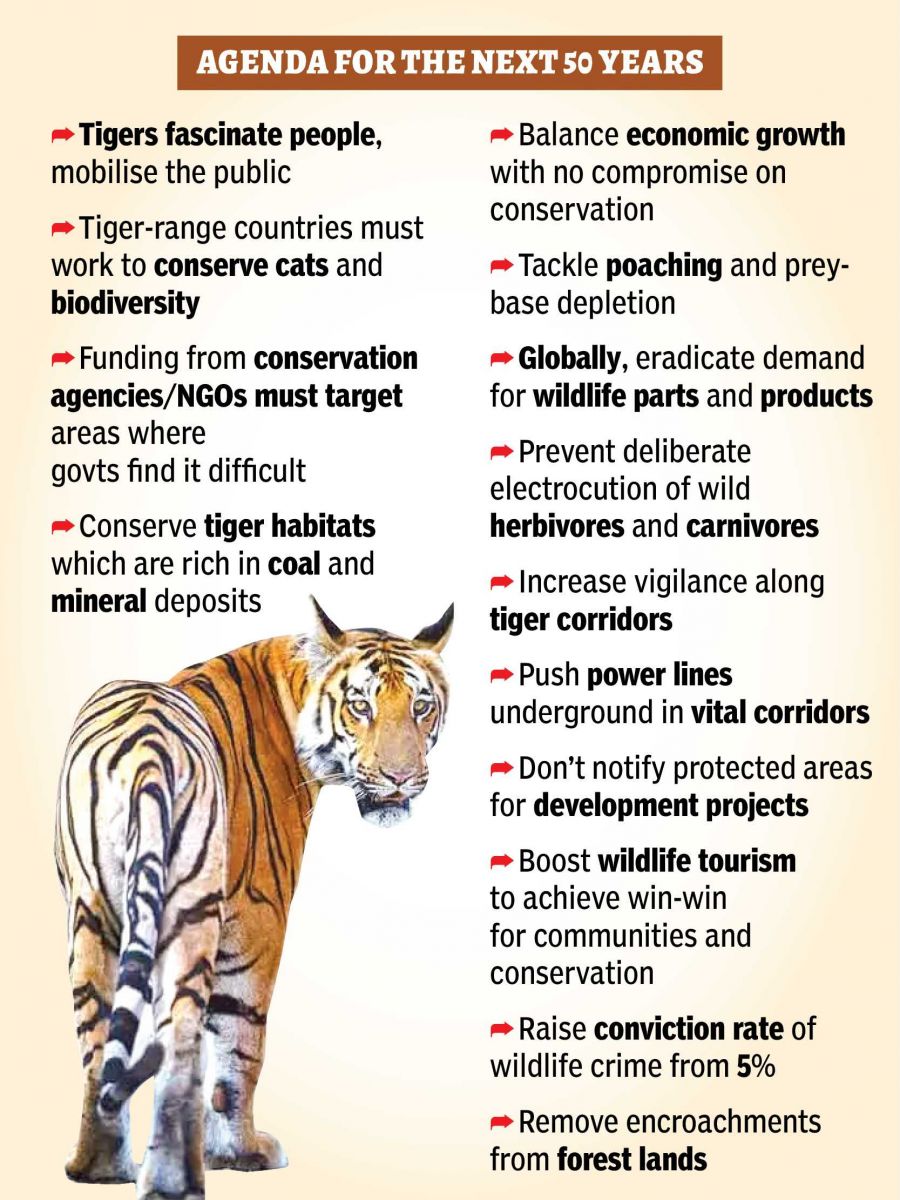- Home
- Prelims
- Mains
- Current Affairs
- Study Materials
- Test Series
Rising Tiger population escalating Man-Animal Conflict

- There are 3,167 tigers in the wild, as per the fifth cycle of India’s Tiger Census released in 2022.
- It has risen to 200 in the past four years, from 2,967 in 2018.
- India has the highest number of Royal Bengal Tigers among 13 tiger range countries.
- The pan-India exercise steered by the Wildlife Institute of India (WII) and National Tiger Conservation Authority (NTCA) has set a Guinness Record for being the world’s largest camera trap wildlife survey.
- Their numbers are expected to increase steadily.
- However, the intensity and frequency of human-animal conflict and associated deaths have been increasing every year.
What is human-animal conflict?
- Human-wildlife conflict is when encounters between humans and wildlife lead to negative results, such as loss of property, livelihoods, and even life.
- Defensive and retaliatory killing may eventually drive these species to extinction.
- It results in suffering for both people and wildlife immediately impacted by the conflict and also has a global reach.
- The long-term survival of species like elephants and tigers, is at risk from an escalating threat of human-wildlife conflict.
- People and wildlife interact and compete for resources due to increased human populations and demand for space.
- It has far-reaching impacts beyond the wildlife and communities immediately affected by it.
- Human-wildlife coexistence is strongly linked and important to sustainable development activities.
- If it is not effectively managed, has the potential to negatively affect activities and conservation in significant manner.
What are causes of the conflict?
Habitat availability:
- Tigers have a large range of requirements to survive, including high-quality habitat composed of core forest.
- Every reserve has a core zone and a buffer zone, where core zones have no human intervention, the buffers are the adjoining areas.
- Villagers living on the periphery of the reserves graze their cattle in the buffer areas.
- Competition between tigers and humans for space is the main factor causing conflicts.
- Human society has continued to dominate the landscape by moving beyond the edges of cities and into wild habitats.
- This incursion of humans and habituation of some wildlife species, has resulted in increased potential for human–wildlife encounters.
- Forest degradation, fragmentation, and habitat loss are incoherent with decreasing tiger habitat and tigers’ prey habitat.
Wild prey availability and territorial wars:
- The depletion of prey by hunting and competition with livestock and other tigers for land are serious threats to tigers over large parts of their range.
- There has been a steady increase in population in the core areas.
- Tigers are solitary and territorial creatures, so with an increase in population, territories overlap, and result in conflict between the cats.
- A dominant male drives out the weaker one and it moves in search of new territory, to the buffer zones, or stray into human landscapes.
- In multiple-use forests, tigers approach villages in search of food.
- Tigers contribute to the death of about 12% of the livestock herds annually.
Human behaviour and activity patterns:
- Activities like herding livestock or tending crops, increase the risk of tiger attacks on people that enter the tiger habitat.
- Humans who entered tiger-established territories in search of wood, honey, or fish, were attacked by Man-eating tigers.
- It was historically documented that individual tigers begin to view human beings as a ‘prey species’ like tigers of the Sundarban delta.
- Illegal access into the core areas by tourists, poachers, and locals for minor forest produce.
- Hunting activities on tigers and other wild species also increase the risk level of tiger attacks.
- A century ago, there were an estimated more than 100,000 wild tigers across Asia but were hunted as trophies and for parts like nails, fur, whiskers, tails and bones.
- Accidental mauling or killing of humans by tigers is rare and usually occurs when angry mobs surround tigers that enter human settlements for livestock.
Socio-economic determinants:
- The factors like attitudes, perceptions, belief systems, educational and value systems, religion, and the economic importance of livestock to communities, led to increased issues.
- People perceive negative attitudes towards certain predator species and tend to prevent future damage by killing the ‘problem animal’.
 Project Tiger Status and Challenges in India:
Project Tiger Status and Challenges in India:
Project Tiger:
- India celebrated 50 years of Project Tiger, by initiatives of National Tiger Conservation Authority (NTCA), and state forest departments.
- It got statutory backup after the creation of NTCA Act, 2006, leading to a change in role by fund disbursing body to an authority for active management of tiger reserves across the country.
- It was launched at Uttarakhand’s Jim Corbett National Park, and later in tiger reserves of Assam, Bihar, Karnataka, Madhya Pradesh, Maharashtra, Odisha, Rajasthan, Uttar Pradesh and West Bengal.
- Now, it covers 53 such protected areas which span to 75,800 sq km.
- The minimum tiger estimates have been collected based on camera trap images, and direct and indirect evidences.
Challenges:
- The tiger corridors are prone to hindrances due to linear infrastructure and other developmental activities, resulting in an impediment in the movement of tigers and the diversion of forest lands.
- The villages near Bandipur and Nagarahole reserves have a large livestock population.
- The further increase in tiger population may escalate the man-animal conflict, especially in habitats with elephants.
- Local communities suffer crop damage (by elephants) and human deaths (due to tiger and elephant attacks).
- A high prey base will reduce the range of the resident tigers and their propensity to stray into human habitats.
- The stimulation for a higher density would be dangerous as it may have reached saturation point in terms of its tiger and prey population.
- The situation beyond the carrying capacity could adversely impact the population of other co-predators like leopards and dholes.
- A long-term challenge is to protect potential tiger habitats with low densities.
Sustainability and Future Directions:
- Caution is advised against artificial intervention or habitat manipulation to augment the population of tiger prey.
- It is difficult to secure the future amidst developmental pressure and dilution of forest conservation laws.
- There is a need for global cooperation, concerted actions, and distribution of resources.
- Facilitating the dispersal of tigers in ranges where the forests are contiguous.
- For example, the Malai Mahadeshwar Hills Wildlife Sanctuary, is said to be ideal as a sink to absorb the surplus tiger population.
- It is linked to the Cauvery Wildlife Sanctuary (Karnataka) to its north and east, the Sathyamangalam Tiger Reserve (Tamil Nadu) to its south, and Biligirirangana Hills Tiger Reserve (Karnataka) to its west.
 What are the Mitigation measures against the conflict?
What are the Mitigation measures against the conflict?
- Strengthening corridor connectivity.
- Providing viable wildlife habitat and creating additional space for tigers.
- Ensuring strict implementation of Eco-Sensitive Zone rules.
- Reducing anthropogenic pressure on existing habitats.
- Taking the local populace into confidence.
- Allaying fears of displacement for tribal communities.
- Adopting approaches that identify and address underlying causes of conflict while developing systemic, context-specific solutions.
- Participation of affected communities as active and equal role in the process.
Human-wildlife conflict management strategies can create opportunities and benefits not only for biodiversity and, but for society, sustainable development, production, and the global economy at large. In order to reduce human-wildlife conflict, we must reassess the relationship between people and wildlife to improve our coexistence, which is both possible and attainable.









 Latest News
Latest News
 General Studies
General Studies